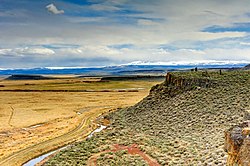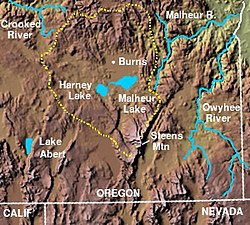Malheur Wildlife Refuge
| Malheur National Wildlife Refuge | |
| Protected Area | |
|
A view of Steens Mountain from an overlook located in the Malheur National Wildlife Refuge
|
|
| Country | United States |
|---|---|
| State | Oregon |
| Region | Harney County |
| City | 30 miles (48 km) south of Burns |
| River | Donner und Blitzen River |
| Location | Harney Basin |
| - elevation | 4,121 ft (1,256 m) |
| - coordinates | 43°15′57″N 118°50′39″W / 43.26583°N 118.84417°WCoordinates: 43°15′57″N 118°50′39″W / 43.26583°N 118.84417°W |
| Area | 293.37 sq mi (760 km2) |
| Founded | 1908 |
|
Harney Basin and surrounding area
|
|
| Website: Malheur NWR | |
Malheur National Wildlife Refuge is a National Wildlife Refuge located roughly 30 miles (48 km) south of the city of Burns in Oregon's Harney Basin. Administered by the United States Fish and Wildlife Service, the refuge area is roughly T-shaped with the southernmost base at Frenchglen, the northeast section at Malheur Lake and the northwest section at Harney Lake.
The refuge was created in 1908 by order of President Theodore Roosevelt to protect habitat for diverse waterfowl and migratory birds, and grew to encompass 187,757 acres (760 km2; 293 sq mi) of public lands. A popular site for birding, fishing, hunting and hiking, the refuge gained widespread attention in early 2016 after its headquarters complex was occupied by armed anti-government protesters.
Archaeological research within the Harney Basin region, including near Burns, Oregon, demonstrates that it likely was home to Native Americans for about the past 16,000 to 15,000 years. The first recognizable remains of seasonal prehistoric dwellings appear later in the Harney Basin at the Dunn Site about 5,500 BP. Around Malheur and Harney lakes, the presence of identifiable remains of numerous settlements and burials of the Boulder Village Period demonstrate that these lakes were heavily utilized by Paiute tribes for hunting and fishing as part of their seasonal nomadic round of the Harney Valley from before 3,000 BP up until historic contact with and settlement of the area by non-Native peoples. For example, the Malheur National Wildlife Refuge Headquarters lies within a major archaeological site that was once a settlement used by Paiute tribes seasonally for thousands of years until historic contact.
The arrival of settlers in the region led to restrictions on the use of the land by the Paiute people who were eventually restricted to living in the Malheur Indian Reservation. After it was established, the size of the Malheur Indian Reservation continued to shrink as small areas of it were repeatedly extracted from it and transferred to local settlers for their private use. The Paiute people were also denied the local fishing and hunting rights that were promised them.
...
Wikipedia



